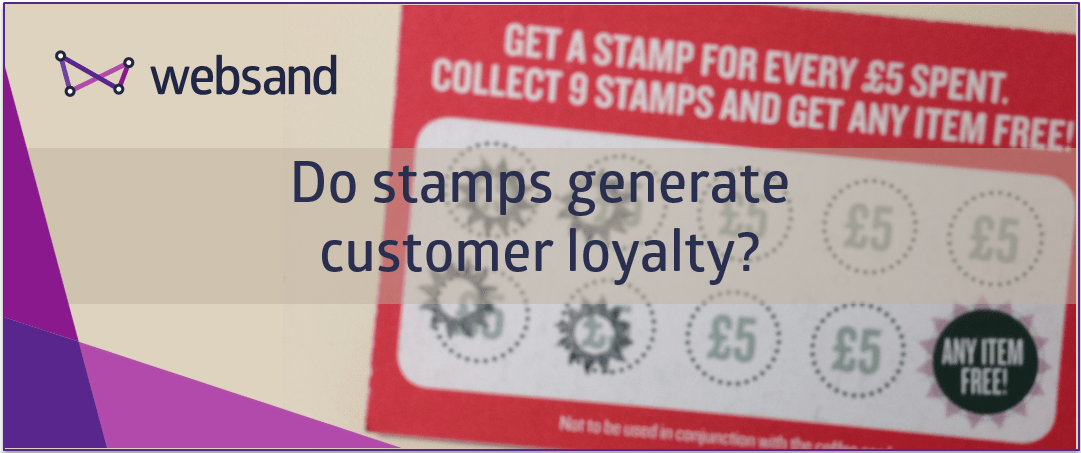Are paper and stamps rewarding?
Loads of small businesses adopt a paper and stamp approach to ‘loyalty’. That’s those paper cards that fill up in your wallet but you can never seem to find when you need them.
The collect a stamp when you buy something loyalty cards. I see them all the time.
They are simple to put into place so they obviously must be working for the businesses involved.
I suppose they can measure the impact by the number of stamped cards in the till, but can you really measure the effectiveness?
Can you identify who is doing what?
Generating Customer Loyalty but Losing Money
Consider this story from Colloquy about a Sushi store in New Zealand. They ran a ‘loyalty’ card in the simplest form.
- Issue the customer with a paper card.
- Rubber stamp at each purchase.
- Buy 10 packs of Sushi and you get a free pack of Sushi.
Some clever sushi lovers took advantage, they ‘acquired’ a stamp, collected some cards and ate for free. The firm ‘St Pierre’s’ estimate that this activity continued over a few years and cost them a few thousand $$ in stock.
This example is the biggest fear factor in putting a simple programme in place, but could be easily avoided.
Connect your customers to the stamps
Replacing the paper card and stamp with technology would give the a business like ‘St Pierre’s’ some extra benefits
- allow the business to collect the contact details of their customers – in doing so building an audience they can communicate to directly.
- understand the recency, frequency and even spend of each customer that has registered – so they can communicate and reward based on the ‘loyalty’ of each customer.
- track the performance of the programme – is it cost-effective.
- preventing fraud – the ‘stamps’ would be directly related to the point of sale, so no extra stamps (unless you issue some free ones to reward extra special customers)
A small investment in technology such as marketing automation software or even customer loyalty software would add huge value to a business such as ‘St Pierre’s’ and prevent clever sushi lovers from taking advantage.
Some coffee based loyalty examples
Starbucks “MyStarbucks” Rewards.
Rather than a typical ‘coffee shop’ paper card used by many many coffee shops around the world, Starbucks adopted a ‘gift card’ style process which has given them huge benefits, and direct access to a Starbucks ‘reward’ community (which means more cost effective marketing).
Starbucks have invested heavily in this, but this investment is working.
They now attribute MyStarbucks Rewards to a global increase in sales as they roll this out across franchises around the world.
Caribou Coffee Perks
As a more realistic example. In the US, Caribou Coffee responded to Starbucks by introducing rewards but in a softer and much less costly manner. Caribou don’t use a card, they use email and SMS marketing.
With Caribou you get a free medium drink when you register, and then alerts as your points balance increases. The really smart bit is that any ‘Caribou’ perks that are ‘cashed’ in need to be used within 7 days – so driving repeat business.
They had over 75,000 customers sign up in the first week![vc_single_image image=”3678″ img_size=”full” onclick=”custom_link” img_link_target=”_blank” link=”https://www.websand.co.uk/pricing”]
Your objectives are the key
Ultimately, the decisions you make need to be driven by the objectives of your business. If you have a paper/stamp solution and it drives repeat spend then that’s great.
However, if you are looking to generate customer loyalty then you need to be able to measure four things.
1) who are my best customers
2) what have they bought
3) have I retained their business
4) how much did it cost
It sounds easy, but you need to know what you are doing. The best bit is you already have all of this information, but it’s hidden. Hidden in sales information and hidden in marketing information. It’s one of the reasons we created Websand, so you can understand the value of each customer and build your business around the customers that love what you do.
Whichever loyalty marketing or customer retention strategy you end up implementing, understanding these measurements give you the foundation to understand what is working and what is not.
If you need any help in this area, let’s have a chat >> get in touch.
